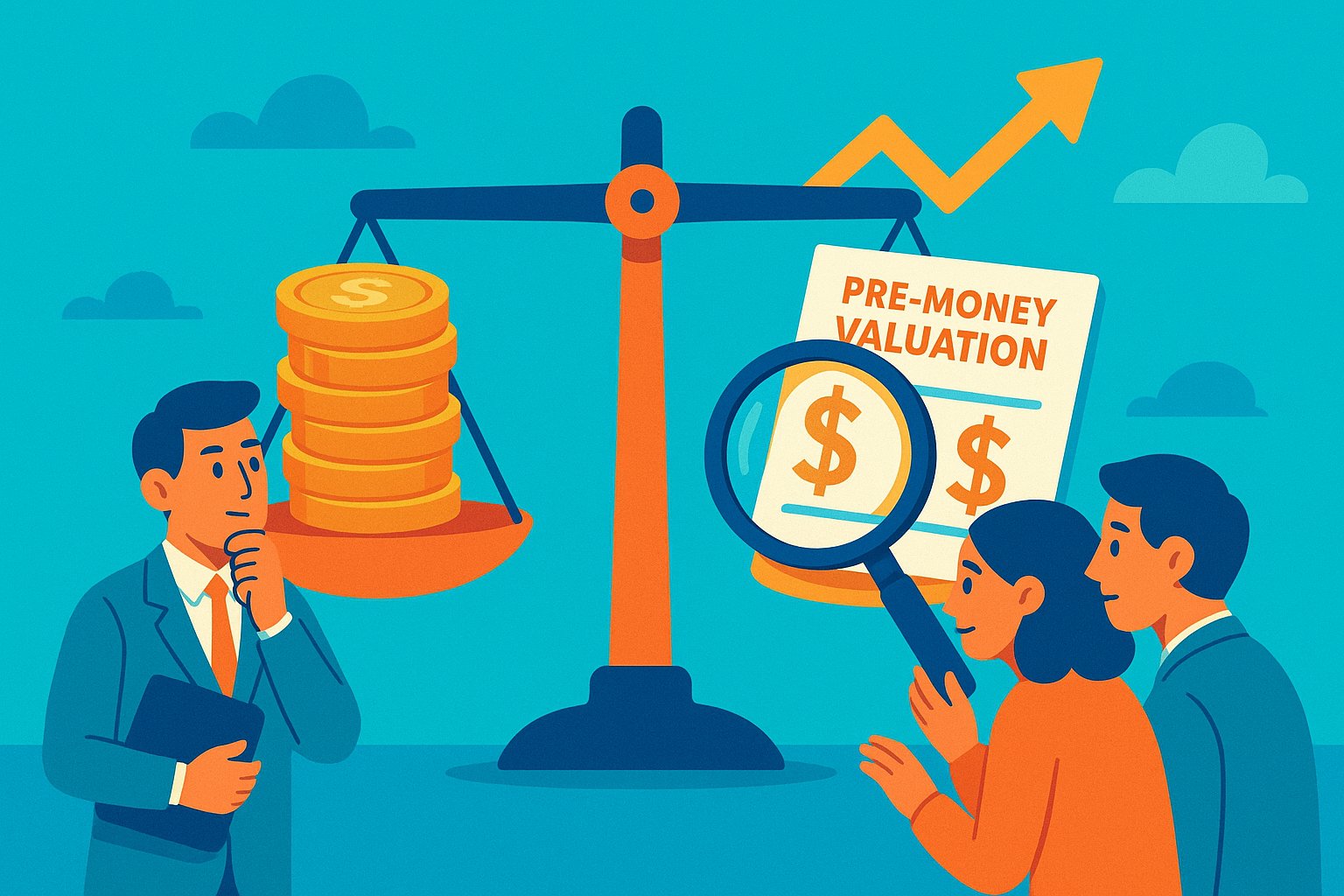Unlocking the Secrets of Startup Valuations
For many investors venturing into the dynamic world of equity crowdfunding, one of the earliest—and most crucial—questions is “What’s this startup really worth?” Unlike public markets, where share prices fluctuate transparently throughout the trading day, private companies rely on negotiated valuations that crystallize at fundraising milestones. Among these, pre-money valuation holds a place of honor: it represents the company’s enterprise value immediately before new capital pours in, setting the stage for how much equity early backers will receive. Grasping this concept is not mere financial trivia; it directly influences ownership percentages, potential return multiples, and, ultimately, your alignment of risk and reward. Yet pre-money valuation can feel like an arcane formula, shrouded in optimistic projections, founder aspirations, and negotiation tactics. In this guide, we’ll strip away the mystique, revealing how pre-money figures emerge, why they matter in crowdfunding campaigns, and how a savvy investor can harness this knowledge to compare opportunities, anticipate dilution, and make informed investment decisions that resonate with long-term growth.
Decoding Pre-Money Valuation: The Core Concept
At its heart, pre-money valuation is a snapshot of a company’s worth just before it accepts fresh investment. Imagine a balance sheet that tallies all assets, intangibles, and growth prospects, arriving at a number that signals how much the enterprise commands on its own. When new funding arrives, that injection of capital increases the total valuation—but only after the pre-money base is set. For example, a startup valued at $5 million pre-money that raises $1 million will boast a post-money valuation of $6 million. This baseline, deceptively straightforward in arithmetic, reflects myriad factors: traction metrics, market size, intellectual property, team pedigree, and comparable exits. As an investor, recognizing the pre-money figure grounds your understanding of what slice of the ownership pie your investment will purchase—and why some campaigns tout high valuations while others trade at modest multiples.
Why Pre-Money Valuations Shape Crowdfunding Campaigns
In the equity crowdfunding arena, transparency is paramount. Platforms display pre-money valuation alongside target raise amounts to help backers evaluate whether a deal offers a fair price relative to potential upside. A lofty pre-money figure suggests strong confidence from founders and early backers, but it also compresses your ownership stake per dollar invested. Conversely, a conservative valuation may imply greater risk but offers more equity for the same check size. For campaign creators, setting the right pre-money valuation is a balancing act: it must attract backers without undervaluing the company, enabling adequate runway for growth. As you browse opportunities, pre-money serves as a quick litmus test—highlighting whether a company’s ambitions align with your investment objectives and appetite for risk.
Platform Presentation: How Crowdfunding Sites Display Valuations
Each crowdfunding platform presents valuation data with its own styling, but the fundamentals remain consistent. On your dashboard, you’ll typically see the pre-money valuation prominently featured near the funding target, sometimes accompanied by a brief narrative justification from the issuer. Some platforms even provide interactive calculators or sliders illustrating how varying check sizes translate into percentage ownership. Underlying these displays, detailed offering documents outline the valuation methodology—whether derived from comparable deals, discounted cash flow models, or revenue multiples. Paying attention to both the headline valuation and the supporting rationale is critical. A pre-money number without context can be misleading; you need to understand the assumptions baked into that figure to gauge its robustness.
Beyond the Headline: Interpreting Pre-Money Against Market Potential
Raw valuation data gains meaning only when weighed against the market opportunity. A $10 million pre-money valuation may look steep for a niche food-delivery startup serving a single city, but it could be conservative for a software platform targeting a global $50-billion industry. To interpret pre-money wisely, juxtapose it with total addressable market (TAM) projections, competitive landscape analyses, and user growth trajectories. If a company’s valuation implies capturing a sizeable market slice mere months after launch, skepticism is warranted. Conversely, undervalued deals might flag overlooked potential or an under-the-radar gem. By embedding pre-money figures within a broader commercial context, you refine your ability to distinguish between hype-driven pricing and valuations anchored in realistic growth scenarios.
Behind the Scenes: Common Valuation Methodologies
Startups employ several methodologies to arrive at pre-money valuations, each with advantages and caveats. Comparable company analysis benchmarks early-stage ventures against similar, recently funded peers, applying industry-standard revenue or EBITDA multiples. Discounted cash flow (DCF) models project future cash flows and discount them to present value—though they rely heavily on management’s growth forecasts. In asset-light businesses, founders may point to user or subscriber counts, calculating implied value per user. Some campaigns lean on milestone-based valuations, tying pre-money floors to reaching product-development or customer-acquisition thresholds. As an investor, scrutinizing which method a startup favors helps reveal whether the valuation is conservative, aggressive, or somewhere in between. By understanding these valuation engines, you elevate your due diligence, probing the soundness of the inputs and guarding against unfounded optimism.
Negotiating Valuation: The Dance Between Founders and Early Supporters
Contrary to the perception of unilateral pronouncements, pre-money valuations often emerge from negotiation. Founders collaborate with lead investors, advisors, and in some cases, crowdfunded backers who commit sizable checks, discussing value drivers and acceptable dilution levels. Accredited anchor investors may secure slightly lower valuations or additional perks—setting benchmarks for the rest of the round. Crowdfunding platforms sometimes facilitate this process by capping the first tranche at a certain valuation or by offering early-bird incentives that effectively reduce the pre-money figure for initial backers. As you assess campaigns, consider how flexible founders appear on valuation and whether lead investors are exercising preferential terms. High founder conviction paired with early-anchor support generally signals confidence; sudden valuation discounts mid-campaign might reflect deeper concerns about drawing sufficient interest.
Common Pitfalls: Misreading Pre-Money Numbers
Pre-money valuation, while illuminating, can mislead if taken at face value. One trap is ignoring subsequent dilution: if a startup plans multiple funding rounds before profitability, your ownership stake shrinks over time absent pro rata rights. Another hazard is conflating pre-money with post-money; confusing the two can lead to overestimating your stake. Investors must also beware of overly formulaic valuations that ignore qualitative factors like team cohesion or regulatory risks. In some cases, startups inflate valuation by citing ambitious back-of-the-envelope calculations for future prospects, without considering execution challenges. To sidestep these pitfalls, anchor your analysis in both quantitative metrics and qualitative insights—questioning assumptions, examining cap tables, and forecasting how future fundraising needs could reshape ownership dynamics.
From Pre-Money to Post-Money: Charting Dilution Trajectories
While pre-money valuation dictates deal pricing, post-money valuation—the sum of pre-money plus new capital—illuminates the immediate impact on ownership percentages. If you invest $10,000 into a $2 million pre-money deal raising $500,000, your pro rata share equates to $10,000 divided by the $2.5 million post-money total. Yet the story doesn’t end there: follow-on rounds, option pools, and convertible instruments can further dilute early backers. Investors should model dilution scenarios, projecting how successive equity issuances might erode initial stakes—and what ownership levels remain meaningful at exit. Crowdfunding platforms occasionally simulate these scenarios for you, but building your own cap table models ensures you capture every planned issuance and conditional conversion. Armed with this foresight, you can negotiate for anti-dilution provisions or set realistic expectations for long-term returns.
Benchmarking Across Deals: Using Pre-Money to Compare Opportunities
Given the diversity of crowdfunding campaigns, investors benefit from standardizing valuations by computing implied per-unit metrics—such as valuation per user, per dollar of annual recurring revenue (ARR), or per active customer. By normalizing these figures across deals in similar sectors, you create a comparison grid that highlights outliers. A SaaS startup valued at $20 million pre-money with 2,000 ARR customers implies $10,000 per customer—an aggressive ratio unless justified by high lifetime value. Conversely, hardware ventures might price per prototype unit or supply arrangement, reflecting capital intensity. This benchmarking exercise helps you prioritize deals with favorable valuation multiples and flag those that warrant further scrutiny. Over time, developing a mental library of typical sector ratios enhances your ability to spot both bargains and overvaluations at a glance.
Essential Tools and Data Sources for Valuation Analysis
To master pre-money assessments, leverage both proprietary platform tools and external resources. Crowdfunding sites often publish valuation calculators, cap table simulators, and downloadable pitch decks, supplying the raw data you need. Complement these with independent databases—such as PitchBook, Crunchbase, or CB Insights—that aggregate deal valuations, funding histories, and sector trends. Financial modeling templates, available through investor forums or educational platforms, allow you to stress-test scenarios by adjusting growth rates, discount rates, and exit multiples. For real-time market sentiment, track newsfeeds and social channels to detect shifts in investor appetite that could influence valuation benchmarks. By integrating multiple data streams, you elevate your analysis from point estimates to multifaceted evaluations, capturing both numerical precision and market psychology.
Turning Valuation Insights into Investment Strategy
Armed with a nuanced understanding of pre-money valuation, you can craft a tailored investment approach. For early-stage diversifiers, targeting lower pre-money deals in emerging sectors can amplify ownership stakes—but demands rigorous due diligence on execution risk. Growth-focused investors might favor slightly higher valuations aligned with proven traction, prioritizing companies that demonstrate consistent revenue growth and market validation. If you possess domain expertise, participating in insider rounds or offering strategic support can justify premium valuations through added value. Conversely, patient investors with ample capital may spread allocations across multiple valuation tiers, balancing risk and potential return. Ultimately, aligning your portfolio strategy with valuation insights ensures that each dollar deployed matches your broader goals—whether that’s outsized upside, steady growth, or sector-specific exposure.
Elevating Your Crowdfunding Journey Through Valuation Mastery
Pre-money valuation stands at the nexus of pricing, ownership, and upside potential in equity crowdfunding. Far from a static figure, it encapsulates a startup’s past performance, current positioning, and future promise—filtered through negotiation dynamics and market sentiment. By deconstructing how pre-money numbers are derived, scrutinizing the assumptions they embody, and modeling their long-term impact on ownership, you transform a seemingly opaque metric into a powerful decision-making tool. Integrate platform features, external databases, and your own financial models to benchmark deals, anticipate dilution, and calibrate your risk appetite. With these insights, you navigate crowdfunding opportunities not as a passive contributor but as an empowered investor—poised to stake your claim in tomorrow’s success stories at valuations that reflect both ambition and prudence.




